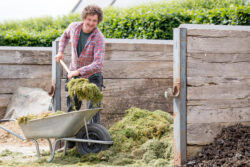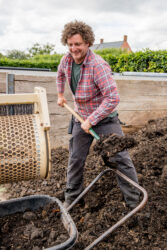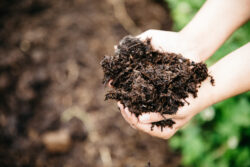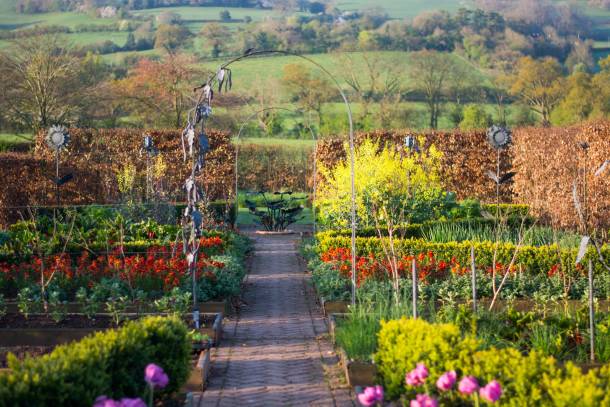Tuesday 15th March 2022
Make your own black gold and your garden will reap the benefits
Our soil has the power to absorb and process carbon from the atmosphere, making it an important element in our efforts to mitigate climate change. Caring for our soil using organic principles is one of the most important thing we can do as gardeners.

We sat down with Matt, one of the gardeners in our Organic Garden ‘As part of my job here at Yeo I am responsible for all things compost. We are very lucky to have a dedicated area of large bays which is where the magic happens! Being an Organic garden we are very soil focused as we believe that if you dedicate time to improving your soil health then the whole garden will see the benefit. We operate a closed system that reuses all our waste materials including pruning’s, clippings, cow poo and leaf mould and we use the resulting compost in mixes for potting, as well as adding it to the soil as mulch to improve structure and to feed the more intensive areas such as the vegetable garden. We also collect and store leaf mould and make our own biochar which we add to our compost mixes to aid water and liquid feed retention, I think it’s safe to say we are properly obsessed!

Our compost yard is set up on concrete with a series of large and small bays. Our smaller bays get filled up on average every six to eight weeks with waste from the garden then we can turn this into compost suitable for a potting mix about four months after the bay is full. The larger bays we use for long heaps which we let mature for over a year to reduce the risk of perennial weeds and self seeders surviving, plants such as bind weed, equisetum and couch grass we try to “weed” (sorry!) out into a rubbish bin to be extra safe. When the heaps are in full swing they can reach temperatures of up to eighty degrees and we love to see the steam rising from them when we disturb them!
All the waste from the garden comes through the yard, we chop it up small to speed decomposition, then layer into the bays using equal parts green and brown material then give it a good mix up! I like the heaps to be nice and springy with lots of air running through layered like a Bake Off cake and with absolutely no soggy bottoms. We turn heaps depending on the time of year roughly every eight weeks which helps to re-distribute the heat within.’
If you have the space, composting on a large scale offers a complete closed cycle system for your organic waste. You can even add cardboard and paper to the heap, helping reduce household waste and reducing your personal carbon footprint. However, even small gardens benefit from a compost bin!

We’ve come up with a few tips for ensuring you get the most ‘black gold’ for your efforts.
- Shred all the waste you plan to add to the heap for better structure
- Add your “greens and browns” in layers to control quantities, then mix well
- Turn your heap regularly to let air in. This speeds up aerobic activity and helps create a useable product more quickly.
- Keep an eye on the moisture levels. Not too wet! Not too dry! Add either ‘green’ or ‘brown’ waste accordingly – green will add moisture and brown will soak it up. Add a high ratio of carbon “browns” to nitrogen “greens”. This will prevent a sloppy heap.
- If you can get hold of some (we have quite a bit), add a few buckets of organic cow manure to help activate the heap.
Good luck and don’t forget to tag us when you post your compost photos on social #yeovalleyorganic #soilheroes
Why not come and have a look at our heaps? The Yeo Valley Organic Garden is open Wednesdays and Fridays, and most Saturdays from 27th April until 30 September 2022. Visits must be pre-booked online, click here to find more.





Sounds great. Will take some tips. Thank you.
Thank you for your advice,
I love compost heaps and I even taste mine!!!
I have an annual cycle for my compost. I fill up my compost bins during the year and then bury it in my bean trench. The beans fix nitrogen in the compost which finishes off the process. Then in the spring I dig out half of the bean trench to use around the garden, transfer the compost into the bean trench and cover with the other half of the bean trench and then fill that half with the rest of my compost.
I started with virtually no topsoil in my beds and now have at least 150 mm everywhere.
A hot compost bin has replaced two open wooden bins. It produces good compost very quickly and has saved a lot of space. Some councils have compost bin offers for residents, it’s worth checking before buying elsewhere. The Gardener’s World magazine website has a review of various types of compost bins.
We do a lot of shredding for our compost which you can mix, green and brown, as you do it. We also put in some brown cardboard. I have heard some say not to put rose and other thorny stuff in but provided you use sturdy gloves when handing the compost the sharp bits can help deter slugs and snails when used as a mulch.